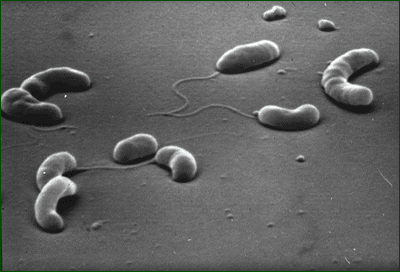Cholera, the most serious acute infectious diarrhea disease, cholera is caused by the choleric vibron and has sudden onset, manifested by acute diarrhea and sometimes vomiting, always followed by rapid dehydration with hypovolemic shock and acidosis. The severity and fatality of the disease have been noted before Hippocrates.
Prognosis depends on the precocity of fair treatment, fatality is over 50% in the absence of therapy and less than 1% with appropriate treatment. With all processes apparent in cholera control, reflected in reducing the overall number of cases and deaths, specific mortality is increasing worldwide.
Cholera is caused by Vibrio cholerae, a gram-negative germ, aerobic, comma-shaped, pathogen only for humans in natural conditions. There are two classic biotypes and the El, the latter being the most prevalent worldwide, more resistant to the external environment and antibiotics like Cotrimoxazole and Ampicillin. Recognition and consideration of work on cholera El Tor dates from the early 60s, simultaneously with the start of the seventh cholera pandemic.
Subsequently there have been such cases detected in Bangladesh and the USA. Work on cholera germ was called Bengal 0-139. Production of enterotoxin vibron after multiplication in the intestinal lumen is the most important valence pathogenicity of work on cholera, plus motility, mucinaza and neuraminidase, due to which it can move actively and flows through the protective mucus layer on the surface of the intestinal epithelium.
Cholera has exterotoxina polymer structure, being composed of a monomer A and five B monomers cholera toxin fragment B is fixed by the specific receptor on intestinal cell epithet (GM1). Incubation of the disease is short (a few hours to 5 days). The clinical characteristics of cholera is more common and less frequently in classical biotype cholera with El Tor biotype.
Source of infection is human: ill, infected subclinical carrier. Cholera is of unknown primary origin. The patient is contagious from the onset of disease through feces and vomit fluid. Excretion of quantitative work on cholera is massive but short-lived, even in the absence of anti-infective treatment. Rarely is in a carrier state, lasting several days most often, chronic carriers are exceptionally rare, usually on the merits of Gallbladder. Work on holera dynamics of excretion is similar in people with subclinical infection, entity made biotype El Tor priority.
Perla is indirect transmission through fecal-oral mechanism. Cholera is the prototype of water-borne infectious acute diarrhea. Water contaminated with a pathological product of infection removed and used as drinking water, washing, cooking or shower\swimming, may transmit the causative agent. Infective dose is between 10.000-1.000.000 germs for classical biotype El Tor biotype and 1000-10.000 for the other types, being smaller if the person is infected with gastric hypochlorhydria. Besides traditional transmission fluid, known possibility of transmission of cholera in various foods is particularly important for local consumption “seafood” caught in contaminated water of estuaries. Cholera can be spread by objects contaminated by dirty hands also. Biotype El Tor survive for a long time outside the human body.
Responsiveness is average in cholera disease with classical biotype (50% disease, 50% subclinical) and lower in cholera with El Tor biotype (25% disease, 25% atypical diarrhea, 50% subclinical). Responsiveness varies with the age and geographic area: children in endemic areas are at maximum. Severe forms of the disease typically occur in the suspects with blood group 0. Stecifica serotype immunity is long-lasting and strengthened by subsequent reinfection.
Potable water poverty in endemic areas, correlated with poor hygienic habits, poor healthcare and low economic and population cultural favors persistence of cholera in the population.
